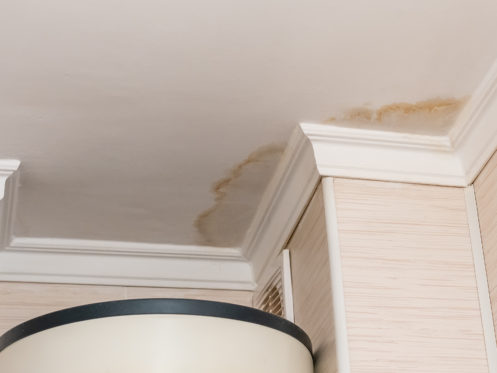
How to Detect Water Leaks in Walls

Plumbing issues such as leaks can cause extensive water damage if not dealt with quickly. The subsequent cost of repairs could run into the thousands in some cases. Some leaks, such as leaks in walls, can be hard to notice. Unlike a burst pipe or faucet leak, undetected leaks in walls are often hidden from view and can wreak havoc on your home before the damage they are causing becomes obvious. From peeling paint and wallpaper to musty smells and mold, these leaks leave several clues behind them.
The good news is that once the leak has been detected, it can be dealt with swiftly. But first, we need to find the source of the leak. In this article, we’ll look at the art of leak detection, the signs to look out for, and what you can do as a homeowner to prevent water leaks in walls from damaging your home.
- Wet or discolored drywall
- Water-stained trim
- Damp masonry
- Musty smells
- Mold or mildew
- Puddles or drips from the ceiling
What Causes Water Leaks in Walls?
There are many causes for water leaks in walls. Some will be obvious, while others may take a while to identify. Let’s take a look at some of the common culprits.
Interior Plumbing
Interior plumbing is a common source of leaks in the walls. A plumber will conduct several tests, including turning off all water and checking the water meter to see if the numbers continue to increase. If they do, this could signify a problem with defective plumbing. From old and worn-out pipes to frozen or burst pipes, many things can go wrong with your plumbing that could cause a leak behind your walls. The good news is that our team is on hand to help with them all.
Exterior Above Grade Problems
The term “above grade” means any part of a property above the ground. If your internal plumbing isn’t causing the issue, your plumber will move their inspection outside your home. Many external factors could be causing your leak, including clogged gutters, downspouts, damaged flashing, chimney damage, or compromised caulking.
Exterior Below Grade Issues
Common causes of a lower level or exterior below grade leak include sprinkler pipes, poor drainage from downspouts, or grading that slopes down towards the house. Slab leaks underneath your home could also cause water to seep up and into your walls from below.
How to Tell When You Have a Water Leak in Your Walls
When a drain backs up or a frozen pipe bursts, you’ll usually know something is wrong immediately. On the other hand, a slow leak in the walls of your home might not attract urgent attention right away, but it does leave behind some signs that something is wrong. Below are some of the clues to look out for.
Persistent Musty Odors
Structural materials can absorb water like a sponge. Over time, as water drips from a leaky pipe behind a wall, the sheetrock and flooring will remain damp and develop a musty odor. If you notice this smell but can’t find an apparent cause, it’s likely a leak behind your wall.
Mold in Strange Places
Mold is common in bathrooms, laundry rooms, kitchens, and basements. If you spot mold growing on the walls in other rooms in your home, you likely have an undetected water leak. In the first instance, you’ll need a qualified plumber to identify the cause of the leak. You may also need to call in the services of a mold removal company to remove the mold altogether.
A Growing Stain on the Wall
Mold can start growing around a leaky pipe in the wall. If left undetected and untreated, mold can begin to grow inside the wall and cause a strain on the outside.
Bubbling or Peeling Wallpaper and Paint
One of the worst things that can happen aesthetically to your home is when a water leak causes your paintwork and wallpaper to bubble or peel. You will need to find and fix the leak, and you’ll usually need to redecorate, too. The faster these leaks are handled, the less extensive the damage.
Warped Sheetrock
When sheetrock wicks up the moisture caused by a slow leak, it will start to bend and warp over time. Call a plumber immediately if your walls have begun to curve or sag, as saturated drywall can eventually buckle and collapse.
Stained Floors and Buckled Ceilings
Stained floors and buckled ceilings can also indicate an undetected leak. Constant dampness inside your walls will eventually cause structural damage to flooring, ceilings, and framing around doors and windows.
Wet Spots and Stains on Your Walls
If you touch your walls and they feel damp or even wet, this is a sure sign of a leak in your walls. Dark paint or wallpaper can disguise wet spots for quite a while, and you may not realize you have a problem for some time. However, the musty smell will usually give the game away. These wet spots are typically caused by water traveling down a pipe and dampening the wall in the process. You might also notice odd discoloration on your walls caused by the damp spots drying out and leaving a stain.
How We Detect Leaks in Walls and Ceilings
So, what happens when there is a leak behind your wall and no easy means of identifying it or repairing it? Unlike some other plumbing companies that might destroy your drywall or dig trenches in your yard to locate a leak, we use the latest technology to get to the source of the problem fast. We have many tricks up our sleeves, but it’s not magic we rely on. If we believe there is moisture in the walls or ceiling, we have a reliable water damage remediation company that we contract out to in order to get it taken care of.
Once we’ve detected where the leak is, we can set about repairing it. Our plumbers have years of experience in leak detection and pipe repair and will have your pipework or any other leak repaired in no time. If you suspect you might have a leak in your wall, it’s time to take action immediately. Call our team, and we’ll arrive quickly with our leak detection equipment. No matter where your leak is originating from, we’ll find it fast and get to work on eradicating it.
First For Leak Detection in Austin
It doesn’t matter where you are in Austin; our experienced plumbers will make light work of any problem and give you peace of mind when the leak is resolved. Call Beyond Wow today to book an appointment with our team.
Ready for Out-of-This-World Plumbing Service?




